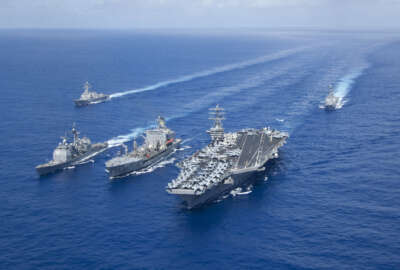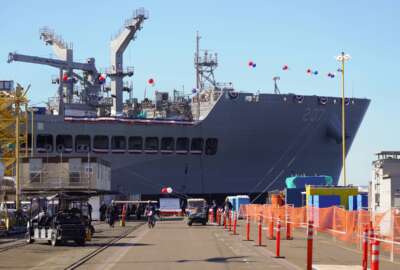Hubbard Radio Washington DC, LLC. All rights reserved. This website is not intended for users located within the European Economic Area.
NAVSUP works overtime keeping up with Navy’s heightened tempo
The Navy runs on ships and people. They need fuel, ammo, food and tons of other stuff. Now ships are on duty around the world, some are on heightened alert.
The Navy runs on ships and people. They need fuel, ammo, food and tons of other stuff. Now ships are on duty around the world, while some are on heightened alert because of the world situation. It all highlights the importance of supplies and the supply chain. For an update, the Federal Drive with Tom Temin spoke with the Vice Commander and Executive Director of the Naval Supply Systems Command, Kurt Wendelken.
Interview Transcript:
Tom Temin And there is a lot going on around the world. Tell us what the top concerns are now for the Navy relative to, say, a year ago or two years ago?
Kurt Wendelken Yeah, well, obviously, the events in the Red sea have become front and center for the Navy. There’s lots of naval activity in that space. I don’t think that was really on anybody’s bingo card for 2024. But that’s where we are. And we’re supporting the fleet and a lot of allied partners engaging in those operations in the Red sea. And we’re still continuing with preparations to make sure we’re ready in the Pacific. And then more broadly, NAVSUP has been working a supply chain transformation program for the last five years, and we’re continuing forward with that as well.
Tom Temin And on the Red sea, I mean, there have been dangers to shipping. And I guess before we get to the specific question there for the Navy, I was wondering, in all the years we’ve spoken, how does the Navy get stuff around? Is it strictly on Navy vessels, or do you use commercial vessels maritime or how it works?
Kurt Wendelken It’s really a mix of lots of cooperation between standard road trucking. Right. A really important part of our supply chain is moving material out of depots. They also could go by aircraft and then ultimately they’re going to end up on a ship at some point and then get delivered to the Navy. So it could go on a commercial ship to a certain point. We work with Transcom as a provider of either government airlift or commercial airlift. And then what we refer to as the last tactical mile is typically done by the Navy, either by a Navy aircraft or a Navy ship. We’ll do the last tactical mile to support Navy vessels that are underway.
Tom Temin So just the sheer movement itself sounds like a pretty heavy logistical exercise.
Kurt Wendelken It really is amazing. We sort of take it for granted because it works so well, but it only works so well because there are so many amazing people, both in the private sector and working for the government, that are making that a success.
Tom Temin So from depots, there might even be overseas depots.
Kurt Wendelken Absolutely. And it varies by what kinds of material we’re moving. But yeah, it could definitely be overseas depots where materials coming from.
Tom Temin And just another detail question. Do things get delivered to ships at sea.
Kurt Wendelken They absolutely get delivered to ships at sea. What’s referred to as unwrap or underway replenishment, where another ship will come alongside the ship and they will refuel the ship while the ship is moving. And then also, very often material will be brought over by helicopter while the two ships are refueling to bring stuff like food and parts and other things like that. So we absolutely get resupplied while we’re underway.
Tom Temin Well, I’ve learned something I thought only aerial refueling was the way thing is moving around in the military.
Kurt Wendelken And again, you know, for people who are interested, I direct you to YouTube to go see some amazing videos of Navy ships getting refueled at sea.
Tom Temin All right. I’m going to take a look at that, because my feeds do show the aircraft being done and flying that boom down into that little tiny nozzle there. So the Red sea, what are some of the specific effects or things you’re watching for right now?
Kurt Wendelken You know, we’re making sure that the vessels that are operating in the Red sea have all the material that they need, and it’s sort of a challenge because that’s not a place where we’ve traditionally operated in this way. For as long as I’ve been working with the Navy, which has been for over 30 years. So what happens is when a new area of operations opens up, then all the logisticians have to figure out how are we getting material there? What new ways do we have to use to get our material there? What are the ports that we can use? What are the airports that we can use? And then what are the challenges of getting material to ships while they’re engaged in operation? So again, I think that’s a novel space that we traditionally have not resupplied in that we’ve had to flex our muscles. And I think both the Navy and our joint partners, like the Defense Logistics Agency and have been rising to the challenge.
Tom Temin What’s the old saying? Amateurs plan battle strategies. Professionals plan logistics.
Kurt Wendelken It’s absolutely true, right? I hate to advertise for myself, but yeah, I think that is absolutely true.
Tom Temin And the South China Sea, that’s been troublesome. You know, if you’re the Philippines and there’s been actual shooting, you know, and so forth and boardings and this kind of thing, the United States has a huge strategic interest there, the pivot to the Pacific and the whole nine yards. What’s the situation there? What are some of the challenges?
Kurt Wendelken So I think that’s an area where we do operate traditionally. So we have more structure there to support us, but we’re really taking a look to make sure that we have everything that we need in place. Should something occur there that requires the Navy to respond on behalf of the nation?
Tom Temin And what about the commercial partners that you might use in areas that are semi contested or temporarily contested? Does that take cajoling to have them go there, or do they have to go to the same places for their other customers?
Kurt Wendelken I think it requires a slightly different way of thinking. But typically, you know, our commercial partners have been alongside with us. The last tactical mile might be the last tactical 100 miles or 500 miles where material will get moved on to a Navy vessel or aircraft earlier to make sure we can bring that material in without placing people in undue danger.
Tom Temin We speaking with Kurt Wendelken. He is the vice commander and executive director of the Naval Supply Systems Command. And just a couple of detailed questions while we have you getting to the supply chain itself. I just read recently that you have standardized contract language for logistical purposes, and I didn’t realize that was a thing. Tell us about that initiative.
Kurt Wendelken So that’s part of our own internal supply chain transformation. One of the things that we really recognized as we started better conversations with our suppliers is that we had to learn to become better customers ourselves. So we discovered that some of our contracts missed some of the configuration management language that we really needed in there, and we’ve been cleaning up those contracts to make it easier for our suppliers to come in and do what are called requests for variances. So if there was something that needed to be changed in how we wrote the contract, we needed to make sure that we had the language in there so they knew exactly what to do. And we didn’t always do that. So there’s a broader Navy effort called Get Real, Get Better, and this is really us working to get real about things that we weren’t doing as well as we could and try to get better. So we had the language in only 17% of our contracts in FY 20, in fiscal year 23. We brought that up to 94%, and now we’re up to 100% in fiscal year 24. So hats off to our contracting team for taking that critical look at how they were working with our suppliers and making things better.
Tom Temin Well, maybe an example of what type of variants might be called for and what would the language say roughly.
Kurt Wendelken So we would ask for something in the contract. There would be a specification in the contract, and maybe the vendor would come back to us and say, hey, I can’t deliver it in exactly that way. I can deliver it in this way, which we think is materially the same. Does the Navy agree? But again, it’s administrivia, right? And sometimes bureaucracies get rightly criticized for making the administrivia too hard. But this is really important administrivia and really is part of us becoming a better customer with our suppliers.
Tom Temin In other words, you could get better value and maybe more efficiency. But for contract language.
Kurt Wendelken I couldn’t have said it better. Right? So it’s really a place where the contractor is trying to help the Navy get a better product or get something on a different timeline. And instead of just saying no, I said it to you one time, just do what I said. It’s really a two way dialog, which is really the way we should be working with our suppliers.
Tom Temin And I imagine this applies to everything from, say, crates of oranges to capstan or shaft bearings.
Kurt Wendelken It can absolutely apply to everything. Right. And I think back to get real, get better. It really highlights what Navy’s trying to do, which is a really important way for Navy to become better and be able to support the nation better.
Tom Temin And you mentioned the supply chain transformation effort. That’s one part of it. What are some of the big things this year?
Kurt Wendelken Right now we’re really focusing on our surface combatants, which are destroyers, amphibious ships. It’s not always clear to the nation what it is that the Navy does, but I think one of the great things that came out of the Red sea is the nation has been able to see our Navy in action. So Navy’s been on a journey where we started working in the aviation space, our supply chain transformation. We then moved to improve our support to submarines, and now we’re working on destroyers to make sure that they have the material that they need on board in the form of spare parts, and that we’re really doing as much as we can to support them, because, again, they’re an important part of what the Navy can do for the nation.
Tom Temin So it’s more of an improvement, say, in just in time or in having the resilience if something goes wrong.
Kurt Wendelken So it’s really both of those things. And I think and you and I have talked about this before, Covid kind of showed us where just in time falls down where, you know, key medical supplies, toilet paper, PPE. Just wasn’t available because businesses had really gone to a just in time model. And what we really have to do as a Navy is we have to balance just in time with having what we need when we need it. So it’s a real challenge to make sure that we’re buying the right material. We use mathematical models and AI to help us do that, but we’re continuing to improve that because we want to make sure we have exactly the material that the fleet needs when they need it.
Tom Temin Right. So you could almost anticipate needs with the right algorithms and the right data ahead of when they themselves might know.
Kurt Wendelken That’s exactly what we want, right? So they have a store of parts on board. So we want to make sure that they’re bringing what they need depending on what part of planet Earth they’re traveling to. And then we want to make sure that we’re backstopping them with more material ashore in case they need it.
Tom Temin It strikes me that because the command of a ship changes regularly and maybe 18 months or whatever, and that captain is gone, NAVSUP, knows the whole history of what’s been going on in terms of requirements for that given vessel.
Kurt Wendelken Absolutely right. And that’s a really important component for us to be able to forecast correctly. And we work very closely with the engineers at NAVSEA to make sure that we’re updating those calculations with the best data that we have.
Tom Temin And a final question. You know, the government has done well on a percentage and dollar basis with small business. But as the Pentagon, you know, writ large, has said, the number of participants from small business is going down. There’s a million reasons for that. What do you hope to accomplish to get more people attracted to military business and NAVSUP?
Kurt Wendelken That’s a great question. The Navy writ large is really, really focused on small business. And we have a number of different programs, including a mentor protege program, where we take a small business. We would team them with a very large defense OEM, and they would help that small business develop their business with the government. And we all have to remember, every large business started out as a small business. They’re really, really critical to both our supply chain at NAVSUP but to our larger economy in the United States.
Copyright © 2024 Federal News Network. All rights reserved. This website is not intended for users located within the European Economic Area.
Tom Temin
Tom Temin is host of the Federal Drive and has been providing insight on federal technology and management issues for more than 30 years.
Follow @tteminWFED
Related Stories
On DoD

WEDNESDAYS, 11 A.M. & 2 P.M.
Each week, Defense Reporter Jared Serbu speaks with the managers of the federal government's largest department. Subscribe on PodcastOne or Apple Podcasts.
Related Stories
-
NAVSUP can teach a thing or two about small business Defense procurements Acquisition Policy





